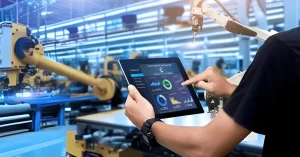In a world where power outages have unfortunately become quite common, the lithium ion inverter battery has proven to be a valuable resource. It has become an integral part of our daily lives and is a reliable backup for our home appliances when electricity is unavailable. Additionally, it plays a crucial role in storing energy, ensuring a continuous power supply in our homes.
If you’ve ever wondered about the inner workings of this battery, then read on. However, before we dive into the technical details, it is essential to understand what a lithium-ion inverter battery is clearly.

Understanding a Lithium Ion Inverter Battery
A lithium-ion inverter battery is a rechargeable battery and employs lithium ions as the charge carriers. These batteries generally include a sequence of cells, each having a positive electrode, a negative electrode, and a separator. They are most commonly employed in off-grid or renewable energy systems.
Working of a Lithium Ion Inverter Battery
A lithium-ion inverter battery incorporates a lithium-ion battery pack with an inverter circuit to convert and deliver electrical energy in a usable form. Here’s how a lithium inverter battery typically works:
- Battery Pack: The battery pack is the lithium-ion inverter battery’s central part. It has multiple lithium-ion cells coupled in series and parallel configurations to acquire the correct voltage and capacity. The battery pack reserves electrical energy as chemical potential energy.
- Charging Process: The charging process of a lithium-ion inverter battery begins when a solar panel or AC power supply is attached to it. The voltage and current command the charging process, guaranteeing the battery charges safely and effectively.
- Battery Management System (BMS): This system in the battery ensures efficient charging in order to avoid overcharging and undercharging. It also balances the charge of each cell. Its primary function is to maintain the battery’s security throughout its process.
- Energy Storage: When an inverter battery starts to charge, it accumulates electrical energy as lithium ions in its cells. The power is stored in the chemical compounds of the electrodes. The important thing to note here is that the type of electrode can be different depending on the battery type.
- Power Conversion: The lithium-ion inverter battery converts the power stored in the battery into electricity that can be utilized to run machines. It changes the direct current (DC) into alternating current (AC), utilizing a circuit with electronic switches.
- Power Delivery: Lights, home appliances, and other electrical loads can all be powered by the inverter’s AC output. To fulfill the needs of the connected devices, the inverter adjusts the AC power output’s voltage, frequency, and waveform.
- Discharging and Recharging: The lithium-ion cells’ stored energy is released when the battery loses charge due to use. Lithium ions go from the anode to the cathode, causing this. Once the battery reaches a specific level, it can be recharged by linking it to an external power source.
The working of a lithium-ion inverter battery requires the working of multiple components together. This helps store energy and deliver power, making it great for different uses like storing energy at home, off-grid power, and backup power.
Conclusion
The lithium-ion inverter battery has undoubtedly revolutionized our energy utilization. It powers our devices and stores renewable energy, becoming an integral part of our daily routines. Understanding its unique efficiency in energy storage and release is crucial. This blog provides all the information you need to understand it better. When purchasing a lithium-ion inverter battery, trust the reputable brand Luminous. With their commitment to innovation and reliability, they offer high-quality solutions. With their help, you can make intelligent choices and contribute to a more sustainable tomorrow.






